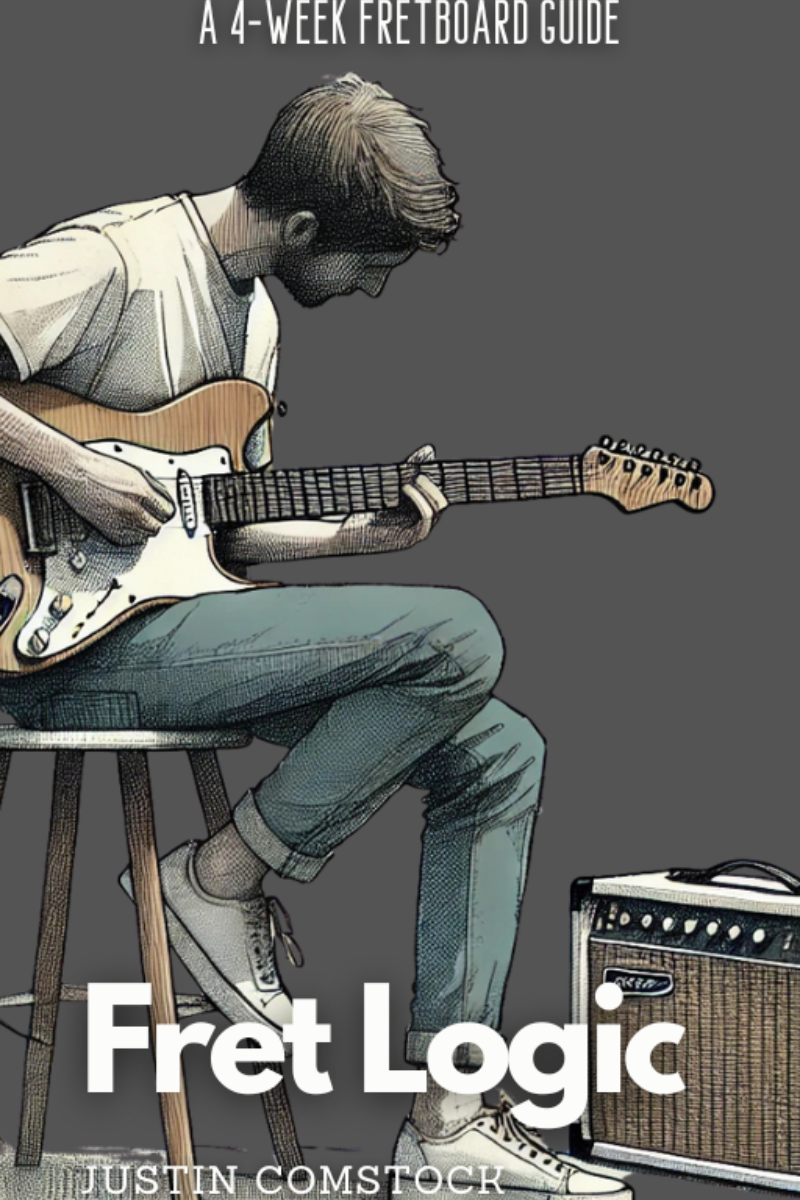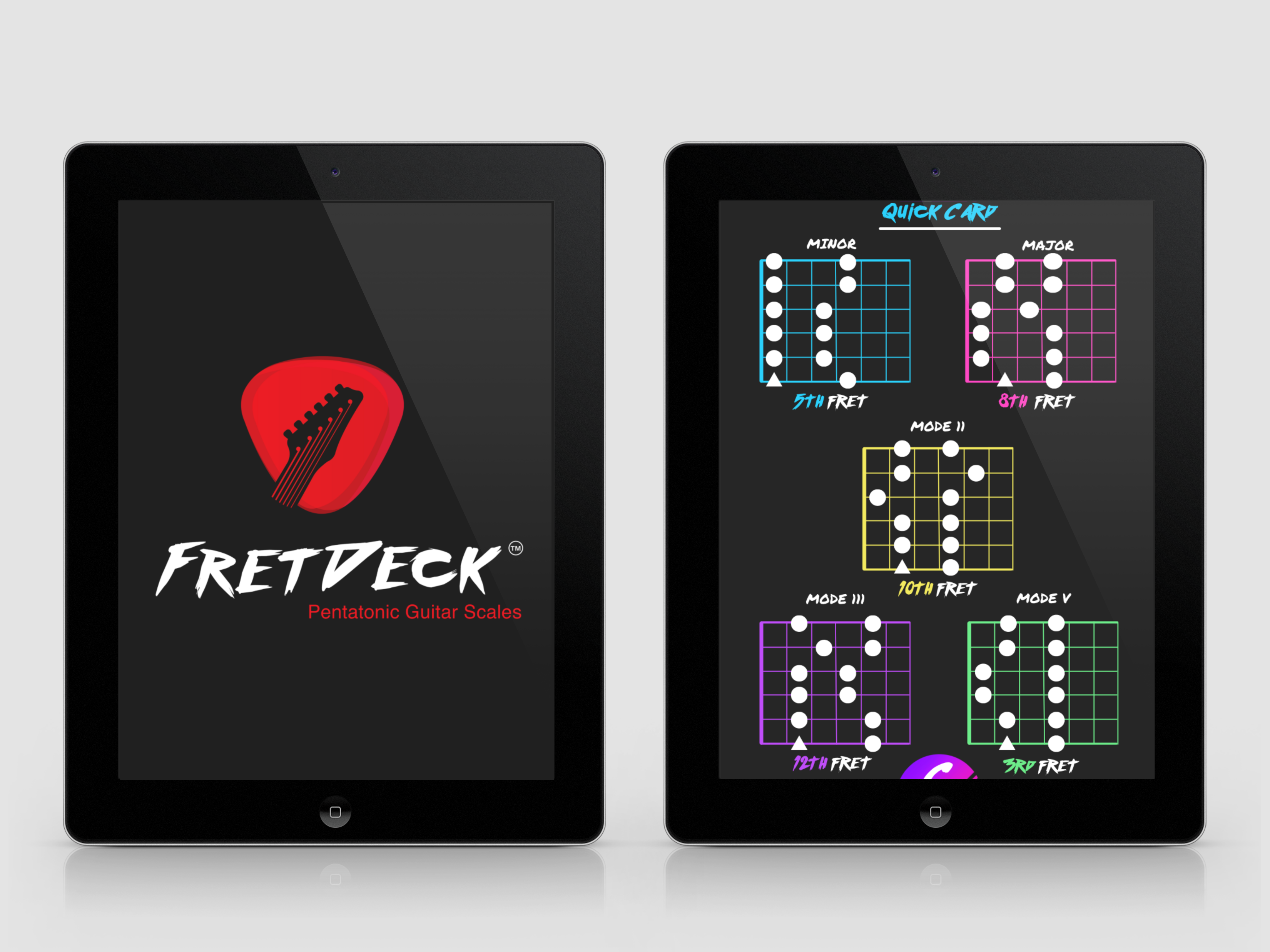When it comes to scales that just work—no matter your style—the major pentatonic scales on guitar earns a permanent spot in your toolkit.
Its five simple notes sound bright, melodic, and clean, fitting everything from rock anthems to country ballads to blues jams.
Today, you’ll learn 8 ways to unleash the major pentatonic scale in your playing.
No theory rabbit holes—just practical ideas you can plug straight into your next practice session.
And if you want to really master pentatonics, I’ll show you how to grab the FretDeck and join our free Discord community at the end of this guide.
Let’s get into it.
What Is the Major Pentatonic Scales On Guitar? (And Why It’s So Damn Useful)
Think of the major pentatonic scale as the “streamlined major.”
Instead of seven notes, it’s stripped to five—cutting out the 4th and 7th scale degrees that can sound dissonant.
Formula:
1 – 2 – 3 – 5 – 6
Example in C Major:
C – D – E – G – A
This simplicity is what makes it so versatile—you can move around the fretboard without stumbling into clashing notes.
✅ Pro Tip: You’ll find the major pentatonic hiding in some of your favorite songs. Once you learn to recognize it, you’ll hear it everywhere.

❌ Stop Guessing. Start Shredding.
If you’re still fumbling through scale patterns and box shapes… it’s costing you progress.
FretDeck™ is the no-fluff system that shows you exactly how to master the fretboard—fast. Early access.
⚡️ This isn’t for dabblers. It’s for players who want results.
👉 Click here to join the pre-launch now
Early access. Limited rewards. Don’t wait.
1️⃣ Build Melodies That Stick
When you want a melody that feels instantly singable, start here.
Because the scale sidesteps tension, everything you play sounds clean and musical.
Try this:
- Pick just 2 or 3 notes and create a short motif.
- Repeat it with slight rhythmic tweaks.
- Move up an octave to develop the idea.
🎸 Example in G Major Pentatonic (G–A–B–D–E):
Focus on G, B, and E to build phrases that feel resolved.
👉 Challenge: Write a 4-bar melody using only the major pentatonic. Record it. Listen back. If it feels catchy, you’re doing it right.
2️⃣ Solo Over Major Chords
This is where major pentatonic scales shine.
If you’re jamming over a I–IV–V progression, you can use the scale to glide over chords effortlessly.
Try this exercise:
- Play a C–G–F progression.
- Use C Major Pentatonic (C–D–E–G–A) over everything.
- Land on chord tones when the chords change.
🎯 Pro Tip: Emphasize the root, 3rd, and 5th for instant connection to the harmony.
3️⃣ Sweeten Dominant Chords Without Clashing
Over a C7 chord, you could play Mixolydian, but sometimes simpler is better.
The major pentatonic scale gives you the color without the tension.
Here’s how:
- Over C7, play C Major Pentatonic.
- Over F7, switch to F Major Pentatonic.
- Over G7, use G Major Pentatonic.
Result: Smooth transitions with no sour notes—perfect for blues and early rock feels.
4️⃣ Blend Major and Minor Pentatonics
This is a secret sauce pro players swear by.
Bright and sweet meets raw and bluesy when you combine minor and major pentatonic scales on guitar.
In A:
- A Major Pentatonic: A–B–C#–E–F#
- A Minor Pentatonic: A–C–D–E–G
👉 Tip: Start a lick in the major pentatonic, then slide into minor for contrast.
It’s the quickest way to add emotion and edge to your solos.
5️⃣ Create Country Licks That Sing
Country guitar lives in the major pentatonic.
You’ll hear it in the chicken pickin’ of Brad Paisley and the smooth bends of Vince Gill.
How to get started:
- Pick G Major Pentatonic.
- Use double stops and slides.
- Bend the 2nd or 5th scale degree for that signature twang.
✅ Example lick idea:
Slide from A to B, hit the open G, then hammer-on to D. Simple, melodic, country gold.
6️⃣ Craft Chord-Based Solos
When you’re soloing with the chords—not just over them—everything locks together.
Try this approach:
- Over D chord: D Major Pentatonic.
- Over G chord: G Major Pentatonic.
- Over A chord: A Major Pentatonic.
Switch scales as the chords change.
This keeps your lines harmonically grounded and interesting.
7️⃣ Build Arpeggios From Pentatonics
Want to sound more sophisticated without memorizing 100 arpeggio shapes?
Use your pentatonic scale.
Example in C Major Pentatonic:
C–E–G = C Major Arpeggio.
✅ Pro Tip: Practice arpeggios inside the scale pattern. You’ll stay locked into familiar territory while adding variety to your lines.
8️⃣ Play Over Minor Chords (Yes, Really)
Here’s a move most players overlook:
Playing a major pentatonic over a minor chord can create beautiful tension and unexpected color.
Example:
Over Am, play C Major Pentatonic scales on guitar (the relative major).
This gives your solo a hopeful, almost bittersweet feel.
🎸 Try this progression:
Am – G – F.
Solo with C Major Pentatonic over all three chords.
Listen to the mood shift—like sunshine breaking through clouds.
Improvisation Tips for Major Pentatonic Scales
Before you dive in, keep these tips in your back pocket:
✅ Phrase Targeting:
Land on chord tones—root, 3rd, 5th—when the chords change.
✅ Rhythmic Variation:
Mix triplets, rests, and long notes to avoid sounding mechanical.
✅ Use Space:
Leave room between phrases. Silence makes everything you play feel more intentional.
Ready to Master Pentatonics for Good?
If you’ve been nodding along thinking I need a system, here’s your next step:
🎁 Download the FretDeck & Pentatonic Secrets Course
Inside, you’ll get:
✅ All 60 pentatonic scales in every key.
✅ 6 chord progressions to practice connecting scales to real music.
✅ 6 improvisation exercises to build confidence fast.
🎸 Bonus: Join the Guitar Freaks Hangout on Discord and grab my e-book Fret Logic—free for all new members.
👉 Click here to download the course and join the Hangout
Final Thoughts
The major pentatonic scale is more than a fallback—it’s a creative playground.
From country licks to soulful melodies, from shimmering leads to confident chord-based solos, it will always be there when you need something that just works.
Start applying these 8 ideas today.
You’ll be amazed at how much more connected, fluid, and musical your playing becomes.
🎸 Join the Guitar Freaks Hangout
Surround yourself with players who are as committed as you are.
Share riffs. Get feedback. Grow together.
👉 Join now and grab your free Fret Logic e-book

Join Guitar Freaks Hangout on Discord! 🎸
Get Fret Logic FREE!
Join the Guitar Freaks Hangout Discord and get exclusive access to my entire e-book, Fret Logic! Master the fretboard and elevate your solos with this comprehensive guide.
👉 Don’t miss out—join now and download your free copy!
🎶 Keep picking,
—Guitar Freaks Blog
✅ Internal Link Suggestion (use in the post):
👉 Learn more about visualizing your fretboard notes:
https://guitarfreaksblog.com/guitar-fretboard-notes-diagram-your-ultimate-map-to-musical-freedom/

Download The FretDeck & Pentatonic Secrets Course!
Download Our Course










